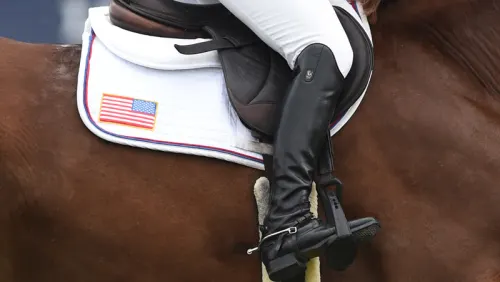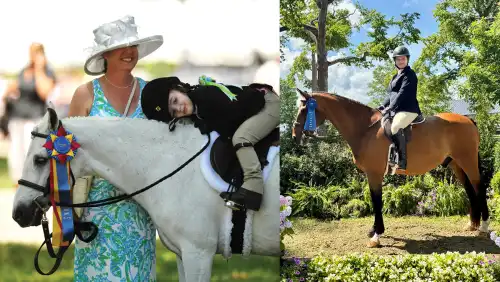In the first of this three-part series about “the mollification of American show jumping,” our columnist looks at the way bad horses make good riders.
Recently, several prominent trainers and riders have discussed how the discipline of show jumping has changed, and it has.
Prior to 1950, American show jumping, with its standing martingales and rub classes without time allowed, was a vastly different sport than the one practiced in Europe. Then in the 1970s, Jerry Baker and Gene Mische, along with the renowned course designer Pamela Carruthers, brought European-style grand prix jumping to the United States, and U.S. show jumping embarked on a meteoric rise.
The Cleveland Grand Prix and the Tampa Invitational (Fla.) introduced width, water, walls, combinations and banks to our grand prix riders. Many barns built simulated natural obstacles at home, and the professionals at that time had to learn how to ride, train and jump them. Double ditches, slides, tables, devil’s dykes and open waters were all routine jumps in our day.
Starting in the 1970s, the American Grand Prix Association developed a year-long series of events across the country. The fences were big, the water wide, and the riding was physical. The American Invitational and the International Jumping Derby in Rhode Island, modeled after the Hickstead and Hamburg Derbies in Europe, tested the scope and courage of riders and horses. Today, I doubt any one of our U.S. grand prix riders could jump a clear round over that course. In fact, how many of our country’s riders have even successfully competed in the Hickstead Derby, the Hamburg Derby or the Helsinki Derby in the last five years? I would venture to guess you could count the answer on your fingers.
Only Spruce Meadows (Canada) has maintained the standards of jumping that we used to have in the United States and that we were exposed to by Baker, Mische and Carruthers. There are no slides or bank jumps in our grand prix classes today. Few grand prix events still use the water jump, and I can only think of two venues that have shallow ditch jumps.
Our younger riders today don’t have the necessary experience, toughness and knowledge to jump those courses. They may tell you that their horses are too valuable or too good to risk injury in such an event. That is not true. The horses today are no more valuable in relative terms today than ours were then, and their legs were no less susceptible to injury back then.
ADVERTISEMENT
If it was Baker, Mische and Carruthers who introduced us to those jumps, it was Bertalan de Némethy, George Morris, Frank Chapot, Neal Shapiro and others who taught us how to ride and jump them. These coaches bridged the gap between American and European show jumping. Although our younger riders today ride well, they again don’t have the mental or physical toughness to jump what we jumped 40 years ago. Well-meaning and wealthy but misguided parents try to help their children by making everything too nice and simplified, and this ultimately stunts their growth and potential as world-class riders.
Thelwell Ponies Taught Grit
These top, up-and-coming young riders of today likely never had a Thelwell pony like we did as kids. I’m referring to the kind of pony depicted in Norman Thelwell drawings; this is the pony that your parents bought you that was cute and you loved to death, but he would always dump you at the coop jump or stop and spin at the far end of the ring, leaving you to walk back to the barn and get back on.
We kept at it though, and we kept getting spat on the ground until we learned how not to get spat on the ground. Then we learned how to find a way to get that pony to jump the coop or ride around the far end of the ring. Once the pony couldn’t get us off, it learned it was easier to just do it; the lesson was learned and the corner turned. Our Thelwell ponies developed grit in us as young riders, an “I’m going to get this done” attitude. Later on, George Morris would describe this as riding “over, under or through” the obstacle. For us it was just a matter of pride.
Many elite riders today bypassed the Thelwell pony and never had to sort through all the backyard problems. Meaning well but doing harm, parents who can afford to send their children on the show circuit often replace a problematic pony or horse instead of letting the rider work through the problems. Only riding good horses and never working through the problem ones causes a developing rider to be shallow. These riders will perform well when everything is good—the course, the footing, the horse and the weather. It is when things go bad that the superficial riders fold.
There is no “rain check” when you are called to the ring at the Olympic Games, and the skies are pouring down with rain. We used to rub dirt on the inside of soaked breeches to create some friction on a water-logged saddle before going into the ring so we could stay on. We had to jump the left or right third of jumps in the Aachen Nations Cup because the middle was too muddy and deep to jump out of. The professional horseman performs even when adversity strikes, because the professional knows how to deal with it. Thelwell ponies taught us this grit.
Bad Horses Help Make Good Riders
ADVERTISEMENT
In that same vein, learning how to ride bad horses was a necessary part of becoming a really good rider. Some horses have a front end that hangs; some drift right or left over the fence; some have an inherent dislike of water. If the talent was there, we approached these problems as management issues which, if properly handled, could win a lot of classes. It wasn’t easy figuring it out, and there certainly were some unpleasant experiences along the way. Later in my career, understanding how to “ride the problem” made the difference between winning and losing, as well as safety and injury.
Val De Loire, Pantheon, Wallenstein, Grande and Southside were extremely talented horses that won many international competitions, Nations Cups, World Championship and Olympic medals for the United States. Yet they had management problems that their riders needed to deal with. Morris taught us the tough love each one needed to realize its potential. It was physical as well as mental for both horse and rider. Learning to correct the problem was the initial goal. The ultimate lesson was that, like an alcoholic never stops being an alcoholic, a stop never leaves a stopper, and a good rider never forgets that.
The instinct to intervene quickly and effectively with the right aid in the right amount to correct the horse in mid-stride prevents career-ending problems and injuries from happening. It can’t be taught. There is no time to think. It has to be learned. If a horse starts backing off four strides from the water jump, the corrective action has to be immediate, instinctual and part of your psyche. Just watch any of Michael Whitaker’s rides in some major world events if you want to see how a horseman instinctively reacts when things go wrong. Todd Minikus and Will Simpson are examples of U.S. riders today who are able to finesse with the best and manage the worst. Todd used to ride bulls, and Will used to ride The Roofer. Enough said.
This bypassing of the “bad ones” is only the beginning of the mollification of American show jumping that we see today. I look forward to sharing more and looking at where we go from here in the next two parts of this three-part series.
Armand Leone of Leone Equestrian Law LLC is a business professional with expertise in health care, equestrian sports and law. An equestrian athlete dedicated to fair play, safe sport and clean competition, Leone served as a director on the board of the U.S. Equestrian Federation and was USEF vice president of international high performance programs for many years. He served on USEF and U.S. Hunter Jumper Association special task forces on governance, safety, drugs and medications, trainer certification and coach selection.
Leone is co-owner at his family’s Ri-Arm Farm in Oakland, N.J., where he still rides and trains. He competed in FEI World Cup Finals and Nations Cups. He is a graduate of the Columbia Business School in New York and the Columbia University School of Law. He received his M.D. from New York Medical College and his B.A. from the University of Virginia.
Leone Equestrian Law LLC provides legal services and consultation for equestrian professionals. For more information, visit equestriancounsel.com or follow them on Facebook at facebook.com/leoneequestrianlaw.















